|

Spring 2003 (11.1)
Pages
72-73
BP Current Developments
First
Pipe for BTC Pipeline Arrives in Baku
by Tamam Bayatly
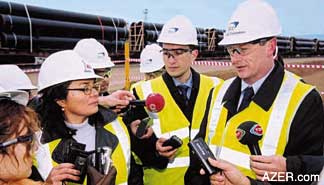  Left: BTC Director Mike Townshend talks to
the press at the Umbaki pipe yard during the first BTC pipe arrival
in Baku. Jan. 28, 2003. Left: BTC Director Mike Townshend talks to
the press at the Umbaki pipe yard during the first BTC pipe arrival
in Baku. Jan. 28, 2003.
In late January 2003,
the first joints of pipe for the construction of the Baku-Tbilisi-Ceyhan
[pronounced jey-HAN] (BTC) pipeline were delivered to Baku from
the Georgian port of Poti on the Black Sea. The first shipment
of 240 joints of pipe was brought by railway from Poti by the
German company Kuehne & Nagle, a freight-forwarding subcontractor
for the Azerbaijan section of the pipeline. The pipes have a
42-inch diameter and were produced in Japan by Sumitomo. The
pipe coating was carried out in Malaysia.
Approximately 39,000 joints of pipe will be needed for the Azerbaijan
section of BTC, which is 460 km long. Transportation of pipe
shipments will take about seven months, with each ship carrying
25 to 30 km of pipe.
The pipe joints are stored in the Umbaki pipe yard near Sangachal,
from where they will be transferred to the pipeline corridor,
known as the "Right of Way" in early April, when physical
construction activities are scheduled to commence.
The BTC project remains on schedule to be completed in time for
First Oil from the Azeri Development Project of the Azeri-Chirag-Gunashli
oil field, which is planned for early 2005.
Stage 1 for Shah
Deniz
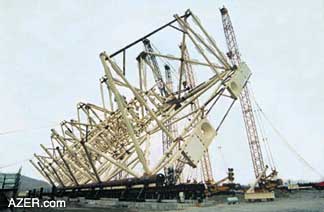  Left: Rolling up the jacket at SPS yard.
December 2002. Left: Rolling up the jacket at SPS yard.
December 2002.
In late February 2003,
the project partners decided to sanction the Stage 1 Development
of the Shah Deniz gas and condensate field in the Azerbaijan
sector of the Caspian Sea. This decision opens the door to a
new East-West Energy Corridor linking the Caspian Sea to Turkey
and beyond.
The parties to the Shah Deniz Production Sharing Agreement (PSA)
are: operator BP (25.5%), Statoil (25.5%), the State Oil Company
of Azerbaijan Republic (SOCAR) (10%), LUKAgip (10%), NaftIran
Intertrade Company (NICO) (10%), TotalFinaElf (10%), and Turkish
State Petroleum Oil Company (TPAO) (9%).
Stage 1 reserves produced during the PSA period are projected
to be 178 billion cubic meters (6.3 trillion cubic feet) of gas
and 34 million tons (250 million barrels) of condensate. At maximum
production, the development is expected to achieve average rates
of 8.4 billion cubic meters per year of gas (900 million cubic
feet per day) and 2 million tons (14.6 million barrels) per year
of condensate. The recoverable reserves of the Shah Deniz field
are 625 billion cubic meters (22.1 trillion cubic feet) of gas
and 101 million tons (750 million barrels) of condensate, with
potential for further hydrocarbons at deeper horizons. The full
production potential of the field is about 16 billion cubic meters
per year, which can be reached through later development stages.
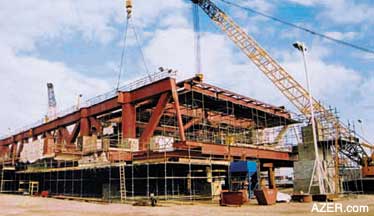  Left: Central Azeri platform integrated deck
fabrication at SPS construction yard. Feb, 28, 2003. Left: Central Azeri platform integrated deck
fabrication at SPS construction yard. Feb, 28, 2003.
Stage 1 includes both
upstream and midstream development with total investments of
$3.2 billion. The upstream project comprises a 15 well-slot TPG
500 type production, drilling and quarters platform to be installed
at a depth of 105 meters; a sub-sea development with five wells
to be drilled at a depth of 300 meters; two sub-sea pipelines
of 100 km each - a 26-inch pipeline for gas and a 12-inch pipeline
for condensate - from the TPG 500 to the Sangachal Terminal;
and gas and condensate processing facilities in the onshore terminal.
The total upstream investment is $2.3 billion.
The midstream project comprises a new gas export system - the
South Caucasus Pipeline (SCP) - from Azerbaijan through Georgia
to the Turkish border. The SCP is a 42-inch, 690-km pipeline
(442 km in Azerbaijan and 248 km in Georgia) to be constructed
jointly with, and in the same corridor as, the BTC oil export
pipeline in order to minimize the environmental and social impact
and to save on capital and operating costs. Construction will
commence in 2004 and will be completed in time to deliver First
Gas to Turkey in 2006.
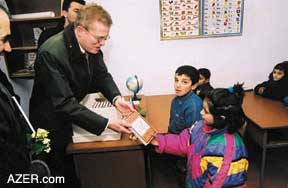  Left: Roger Nunn BP's Reputation & Assurance
Director, handing AIOC-sponsored book on Dada Gorgud to a refugee
girl in BP-refurbished school in Sumgayit. March 2003. Left: Roger Nunn BP's Reputation & Assurance
Director, handing AIOC-sponsored book on Dada Gorgud to a refugee
girl in BP-refurbished school in Sumgayit. March 2003.
Total midstream investment
is $0.9 billion, and will be made by the newly formed South Caucasus
Pipeline Company (SCPC). The funding shareholders of SCPC are
the same as for the Shah Deniz PSA.
Gas sales agreements for Stage 1 have been entered into with
BOTASH of Turkey (6.3 billion cubic meters per year), Azerbaijan
(up to 1.5 billion cubic meters per year) and GIOC (Georgia International
Oil Corporation) (up to 0.8 billion cubic meters per year).
Focus on the Environment
Three Environmental and Social Impact Assessments (ESIAs) have
already been carried out - one for each SCP section in Azerbaijan
and Georgia and one covering the offshore and onshore facilities.
These documents were approved in 2002 by Azerbaijan's Ministry
of Ecology and Natural Resources and Georgia's Ministry of the
Environment. The ESIAs describe the existing environmental and
social conditions around the planned onshore and offshore facilities
and along the pipeline route. They also describe the design,
construction and operation of the facilities, the predicted effects
of these activities and the measures that will be taken to prevent,
minimize and mitigate any potential adverse effects on the ecology
and population.
Safety will be a top priority during construction and an important
criterion for the selection of contractors. There will be a rigorous
approach to training with particular emphasis on frontline supervision,
application of safety management systems and target-setting to
influence safety performance.
Shah Deniz to Provide
Local Jobs
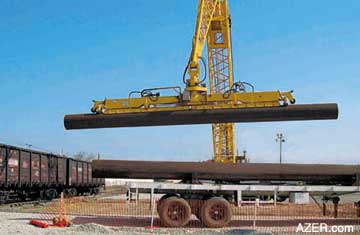  Left: Some of the first pipes arriving for
the BTC pipeline. Left: Some of the first pipes arriving for
the BTC pipeline.
In addition to the direct
investments and state revenues, the Shah Deniz project will provide
significant employment opportunities during its construction
and operating phases.
During construction, the project will provide 4,200 local jobs
for the SCP and an additional 1,300 jobs within the construction
of the onshore and offshore facilities. The Shah Deniz partners
expect that the local procurement strategy under the umbrella
of the Enterprise Center will spur further local small and medium
enterprise (SME) development.
The Enterprise Center in Baku is jointly funded by the partners
in Shah Deniz, AIOC and BTC. Comprehensive training and education
programs are also planned to support construction and subsequent
operating activities.
The Shah Deniz partners are also implementing a $7.5 million
Community Investment Program in Azerbaijan and Georgia. This
program aims to improve social conditions along the pipeline
route and near the Sangachal Terminal, supplementing the $4 million
national and transnational Environmental Investment Programs.
Istiglal Begins
Work on Shah Deniz
The Istiglal semi-submersible drilling rig sailed in early March
2003 to start the Stage1 pre-drilling program in Shah Deniz.
Earlier, the Aura, a Tidewater Marine International vessel under
contract to BP, towed the flotation cradle with a drilling template
to the Istiglal rig. The template, which was installed under
the Istiglal, will be used for the pre-drilling of production
wells.
The Stage 1 Pre-Drilling Program includes the drilling of three
production wells. These operations are planned to commence in
early April 2003 and will continue for 18 to 20 months.
The template was designed by the UWG Group, a company based in
southern England. Fabrication work was carried out by Azfen/Tekfen
in its construction yard near Baku. The contractor used 100 percent
local content, including some 25,000 man-hours of labor employing
some 30 local Azerbaijan citizens. The fabrication of the template,
which is a 41-ton piece of equipment with 15 well slots, commenced
in September 2002 and was completed on schedule at the end of
January 2003.
Progress on Azeri
Project
The Azeri development project has to date performed 10 million
man-hours without any accidents in Azerbaijan. This overall project
progress is four times better than the average BP performance
was in 2002. The project is halfway completed to Central Azeri
First Oil due to be delivered at the end of 2004 with 51 percent
progress in facilities construction and eight of the 12 planned
pre-drilling wells completed.
The project has already exceeded the targets for local jobs,
with 13 million man-hours across 11 countries (10.5 million in
Azerbaijan), currently employing 4,000 local Azerbaijan citizens
and forecast to peak at 6,000 (1,000 more than the target) in
2004.
The year 2003 is expected to be one of unprecedented activity
for the Central Azeri project. An average of $6 million per day
is expected to be spent on construction of the project. Activity
will be built up for the Compression and Water Injection Platform,
West Azeri and East Azeri. All this activity will be conducted
in four major construction areas in the country: Sangachal (terminals),
SPS (construction shipyard), ATA (Azfen/Tekfen/AMEC) and the
Eupec pipe-coating yard.
Helping Refugee
Schools
BP supported an important community development project in Baku's
neighboring city of Sumgayit, which was implemented in collaboration
with the Umid (Hope) Humanitarian and Social Support Center.
This project was aimed at improving conditions in local schools
and supporting the development of education in rural areas.
The project covered the construction of additional classrooms
for two schools in refugee communities now residing in Sumgayyit:
the Ashaghi Jijimli Village School of the Lachin district and
Jabrayil District School No. 4. BP also supplied the schools
with educational facilities and equipment. These communities
have also been receiving support through a larger community development
project undertaken by UNHCR and sponsored in part by Statoil.
In addition, BP in collaboration with Umid, supports the Sema
Community Center in Sumgayit, which works with various groups
of women and children. The Center will receive a community credit
facility that will enable it to provide funds for its members'
entrepreneurial activities. Entrepreneurs will also be provided
with training to help them develop economically viable projects
and make the best use of their loans. Initially, some 10 to 12
entrepreneurs will be supported in their efforts to create or
extend their businesses. The community will use the interest
charged on the loans in part to fund joint activities. For the
first stage of the project, the members have identified the need
to repair the flooring of the community center. This project
was completed in February 2003.
Back to Index
AI 11.1 (Spring 2003)
AI Home
| Search | Magazine
Choice
| Topics
| AI Store | Contact us
Other Web sites
created by Azerbaijan International
AZgallery.org | AZERI.org | HAJIBEYOV.com
|